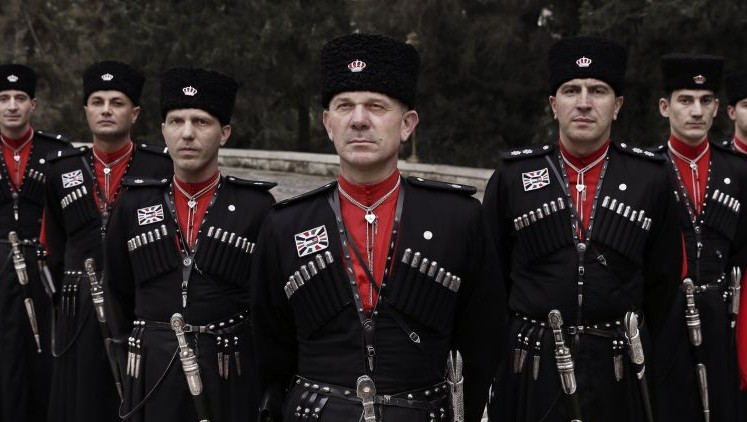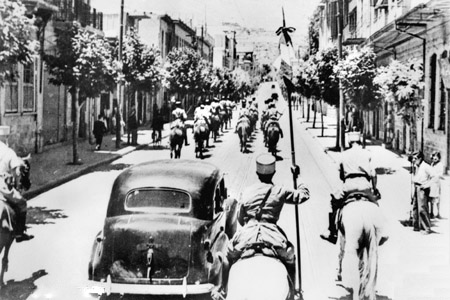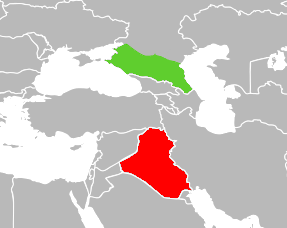|
Circassians
The Circassians (also referred to as Cherkess or Adyghe; Adyghe and Kabardian: Адыгэхэр, romanized: ''Adıgəxər'') are an indigenous Northwest Caucasian ethnic group and nation native to the historical country-region of Circassia in the North Caucasus. As a consequence of the Circassian genocide, which was perpetrated by the Russian Empire in the 19th century during the Russo-Circassian War, most Circassians were exiled from their homeland in Circassia to modern-day Turkey and the rest of the Middle East, where the majority of them are concentrated today. The Unrepresented Nations and Peoples Organization estimated in the early 1990s that there are as many as 3.7 million Circassians in diaspora in over 50 countries. The Circassian language is the ancestral language of the Circassian people, and Islam has been the dominant religion among them since the 17th century. Circassia has been subject to repeated invasions since ancient times; its isolated terrain couple ... [...More Info...] [...Related Items...] OR: [Wikipedia] [Google] [Baidu] |
Circassian Diaspora
The Circassian diaspora refers to ethnic Circassian people around the world who live outside their homeland Circassia. The majority of the Circassians live in the diaspora, as their ancestors were settled during the resettlement of the Circassian population, especially during the late nineteenth and early twentieth century. From 1763 to 1864, the Circassians fought against the Russian Empire in the Russian-Circassian War, finally succumbing to a scorched-earth genocide campaign initiated between 1862-1864. Afterwards, large numbers of Circassians were exiled and deported to the Ottoman Empire and other nearby regions; others were resettled in Russia far from their home territories. Circassians live in more than fifty countries, besides the Republic of Adygea. Total population estimates differ: according to some sources, some two million live in Turkey, Jordan, Syria, and Iraq;Richmond 172-73. other sources have between one and four million in Turkey alone. Middle East A large ... [...More Info...] [...Related Items...] OR: [Wikipedia] [Google] [Baidu] |
Circassians In Turkey
Circassians in Turkey (East Circassian and West Circassian: Тыркуем ис Адыгэхэр, ''Tırkuyem yis Adıgəxər''; tr, Türkiye Çerkesleri) refers to people born in or residing in Turkey who are of Circassian origin. The Circassians are one of the largest ethnic minorities in Turkey, with a population estimated to be two million, or according to the EU reports, three. Circassians are a Caucasian people, and although the Circassians in Turkey were assimilated to some degree, a portion of the diaspora still speaks their native Circassian languages as it is still spoken in many Circassian villages, and the group that preserved their language the best are the Kabardians.Papşu, Murat (2003)Çerkes dillerine genel bir bakış Kafkasya ve Türkiye. Nart Dergisi, Mart-Nisan 2003, Sayı:35 With the rise of Circassian nationalism in the 21st century, Circassians in Turkey, especially the young, have started to study and learn their language. The Circassians in Turkey ... [...More Info...] [...Related Items...] OR: [Wikipedia] [Google] [Baidu] |
Circassians In Israel
Circassians in Israel (; he, הצ'רקסים בישראל) are Israelis who are ethnic Circassians. They are a branch of the Circassian diaspora, which was formed as a consequence of the 19th-century Circassian genocide that was carried out by the Russian Empire during the Russo-Circassian War; Circassians are a Northwest Caucasian ethnic group who natively speak the Circassian languages and originate from the historical country-region of Circassia in the North Caucasus. The majority of Circassians in Israel are Muslims. Israeli Circassians largely adhere to the Sunni branch of Islam; they number about 4,000–5,000 and live primarily in two towns: Kfar Kama ( ady, Кфар Кама, label=none), and Rehaniya ( ady, Рихьаные, label=none). They are descended from two Circassian diaspora groups who were settled in the Galilee by the Ottoman Empire in the 1870s. Circassians are one of only two minority groups in Israel (alongside the Druze) from whom conscripts ar ... [...More Info...] [...Related Items...] OR: [Wikipedia] [Google] [Baidu] |
Circassians In Jordan
Circassians in Jordan (; ) are Circassians living in Jordan. Circassian refugees arrived in Jordan in the late 19th century, after being exiled during the Circassian genocide in the 1860s and later the Russo-Turkish War (1877–1878). They settled in Jordan, then a part of Ottoman Syria, in and around Amman and Jerash. Circassians are credited with founding modern Amman as the city had been previously abandoned. History Exodus Circassians began entering the Ottoman Empire en masse during the expansion of the Tsarist Russian Empire into their Caucasian homeland during the 1850s. An 1860 agreement between the Ottomans and the Russians mandated the immigration of 40,000–50,000 Circassians into Ottoman territory. However, between 800,000 and 1,200,000 Muslim Circassians entered and settled in the Ottoman Empire, of whom some 175,000 were resettled by the government in the Empire's predominantly Christian Balkan territories in 1864. The Balkan Crisis of 1876, which led to the R ... [...More Info...] [...Related Items...] OR: [Wikipedia] [Google] [Baidu] |
Circassians In Syria
The Circassians in Syria ( Circassian: Сирием ис Адыгэхэр; ) refers to the Circassian diaspora settled in Syria (then part of the Ottoman Empire) in the 19th century. They moved to Syria after the Circassian genocide following the Russo-Circassian War. While they have become an increasingly assimilated part of Syrian society, they have maintained a distinct identity, having retained their Adyghe language (in addition to Arabic), their tribal heritage and some of their traditional customs. Prior to the Civil War in Syria, the Circassian population was estimated to be around 100,000 .A Country Study: Syria: Chapter 2 - The Society and Its Environment: Others '' |
Circassians In Iran
The Circassians in Iran (Circassian: Pерсым ис Адыгэхэр, ''Persım'' ''yis Adıgəxər''; fa, چرکس های ایران) are an ethnic minority in Iran. Circassians in Iran differ somewhat from other Circassians in diaspora in that most in the former stem from the Safavid and Qajar era, although a number migrated as muhajirs in the late 19th century as well. The Circassians in Iran were very influential during periods in the last few centuries. The vast majority of them have assimilated to Persian language, and no sizeable number speaks their native Circassian languages anymore. Once a very large minority in Iran, nowadays due to being heavily assimilated over the course of time and the lack of censuses based on ethnicity, population estimates vary significantly. They are, after the Georgians, the largest Caucasus-derived group in the nation. In Persian, the word ''Cherkes'' () is sometimes applied generally to Caucasian peoples living beyond Derbent in Dages ... [...More Info...] [...Related Items...] OR: [Wikipedia] [Google] [Baidu] |
Circassian Americans
Circassian Americans () are Americans of ethnic Circassian origin. The term "Circassian Americans" can refer to ethnic Circassian immigrants to the United States, as well as their American-born descendants. Most trace their roots to Circassians in Syria and Circassians in Turkey, however, there are also those who descend from Circassians in Jordan and other areas of the Circassian diaspora. They mostly live in Upstate New York, California, and New Jersey and number around 25,000. There is also a Circassian community in Canada. History Circassians in the United States all share their common ancestry in Circassia. However, there has been different waves of migrations originating from different regions. There are Circassians in the United States who originate from Turkish Circassians, while some originate from Jordanian Circassians or Syrian Circassians. There are also those whose ancestors directly migrated to the USA after the Circassian genocide. Ottoman Circassians arriv ... [...More Info...] [...Related Items...] OR: [Wikipedia] [Google] [Baidu] |
Circassians In Germany
Circassians in Germany (; ) refers to people born in or residing in Germany who are of Circassian origin. There are around 40,000 Circassians in Germany. History Circassian exile to Turkey After the Circassian genocide, Circassians were exiled to Ottoman lands and initially suffered heavy tolls. The Circassians were initially housed in schools and mosques or had to live in caves until their resettlement. The Ottoman authorities assigned lands for Circassian settlers close to regular water sources and grain fields. Numerous died in transit to their new homes from disease and poor conditions. Most Circassians ended up settling in Anatolia. As a result, Turkey has the largest Circassian population in the world. Circassian immigration to Germany West Germany signed a labour recruitment agreement with the Republic of Turkey on 30 October 1961, and officially invited the people of Turkey to emigrate to the country. As a result, Circassians in Turkey began to immigrate to Ger ... [...More Info...] [...Related Items...] OR: [Wikipedia] [Google] [Baidu] |
Circassians In Egypt
The Circassians in Egypt (; ) are people of Egypt with Circassian origin. For centuries, Circassians have been part of the ruling elite in Egypt, having served in high military, political and social positions.Lewis, Martin WThe Circassian Mystique and its Historical Roots Retrieved 18 May 2015. The Circassian presence in Egypt traces back to 1297 when Lajin became Sultan of Mamluk Sultanate of Egypt. Under the Burji dynasty, Egypt was ruled by twenty one Circassian sultans from 1382 to 1517. Even after the abolishment of the Mamluk Sultanate, Circassians continued to form much of the administrative class in Egypt Eyalet of Ottoman Empire, Khedivate of Egypt, Sultanate of Egypt and Kingdom of Egypt. Following the Revolution of 1952, their political impact has been relatively decreased. With the lack of censuses based on ethnicity, population estimates vary significantly. Mainly of mixed Circassian origin, the Abaza family, one of Egypt's richest families, and is the largest ex ... [...More Info...] [...Related Items...] OR: [Wikipedia] [Google] [Baidu] |
Circassian Flag
The Circassian flag (or the Flag of Adygea) is the national flag of the Circassians. It consists of a green field charged with twelve gold stars, nine forming an arc resembling a bow and three horizontal, also charged with three crossed arrows in the center. Seferbiy Zaneqo, a Circassian diplomat, is the designer of the flag. Every year, April 25 is celebrated as the Circassian flag day by Circassians. Info Symbolism and meaning The green represents nature and Islam. The golden colour represents a bright future in peace and the plentiful harvest of grain and wheat. There are twelve stars, representing the twelve provinces of Circassia. There are three arrows, a reference to Adyghe Xabze in which they would mean "peace if you are my friend, war if you attack me". History and usage Creation of the flag An invasion of Circassia by Russia started in 1763, and since then, the Circassians have been fighting the Russo-Circassian War in defense of their territory. The ... [...More Info...] [...Related Items...] OR: [Wikipedia] [Google] [Baidu] |
Circassians In Iraq
Circassians in Iraq (; ) refers to people born in or residing in Iraq who are of Circassian origin. Like all Iraqis, Circassians in Iraq faced various hardships in the modern era, as Iraq suffered wars, sanctions, , and civil strife. History Iraqis of North Caucasus origin mainly originate from Circassia. The migration of North Caucasians to Iraq goes back many centuries, peaking in the aftermath of the with the of the 1860s. The Circassians ame to Iraq in two waves: directly from Circassia, and later from the Balkans. Chechens and Dagestanis also settled in Iraq throughout the . Circassians also settled in large numbers in other neighbouring countries including Turkey, Syria, Jordan, and Palestine. Demographics The name " Circassian" usually denotes speakers of only, however in the name may denote in general, including Chechens and Dagestanis, who speak . The overall number of Circassians or people of North Caucasus origin in Iraq is estimated to be between 30,000 and ... [...More Info...] [...Related Items...] OR: [Wikipedia] [Google] [Baidu] |
Adyghe Language
Adyghe ( or ; ady, Адыгабзэ, Adygabzə, ), also known as West Circassian ( ady, link=no, кӏахыбзэ, khaxybzə), is a Northwest Caucasian language spoken by the western subgroups of Circassians. It is spoken mainly in Russia, as well as in Turkey, Jordan, Syria and Israel, where they settled after the Circassian genocide. It is closely related to the Kabardian (East Circassian) language, though some reject the distinction between the two languages in favor of both being dialects of a unitary Circassian language. The literary language is based on the Temirgoy dialect. Adyghe and Russian are the two official languages of the Republic of Adygea in the Russian Federation. There are around 128,000 speakers of Adyghe in Russia, almost all of them native speakers. In total, some 300,000 speak it worldwide. The largest Adyghe-speaking community is in Turkey, spoken by the diaspora from the Russian–Circassian War (–1864). In addition, the Adyghe language is ... [...More Info...] [...Related Items...] OR: [Wikipedia] [Google] [Baidu] |





